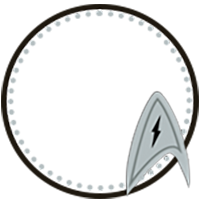‘The damn thing…’
Valance turned in her chair towards the Science console at Airex’s furious mutter. ‘Commander?’
‘Sorry, Captain.’ He looked up, exasperated. ‘You’re not going to believe this. The comet accelerated.’
‘Accelerated.’
‘He’s right, Captain,’ called Lindgren from helm, hands drifting over controls. ‘More than that, I think it responded to us. I brought us closer and matched speed and course. Exactly thirty seconds later.’
Valance stood. She hadn’t fully comprehended why Rourke had always been jumping to his feet when there was a perfectly good command seat, but there was something passive about remaining in the chair in a confusing situation. Standing, she could be a rock in a sea of chaos, and more easily turn to take in the web of information flowing about her bridge. ‘What do our scans now say about this “comet?”’
‘Nothing new,’ said Airex, looking and sounding very unhappy. ‘All we’re still reading is that the nucleus is approximately 12 kilometres in diameter, and looks like a rubble pile – it’s a large number of small pieces. But I’m only picking up indications of silicate and dust particles. I’ve been going over the readings again and again on our approach.’
Valance tilted her head. ‘What about the ice on the surface?’
‘High in deuterium…’
‘Is there anything else about it? Now we’re closer?’
The pause was filled only with the chirrups of Airex’s controls. At last, he sucked his teeth. ‘That’s interesting. It was impossible to discern from a distance. But it looks like the ice around the nucleus is absorbing approximately forty percent of my scans. We’ve been getting an incomplete picture the entire time.’
‘Whatever’s in that ice,’ deduced Valance, ‘is shielding the comet from further scrutiny. Can you pierce it?’
‘Perhaps,’ said Airex, ‘but we’re only an hour out from Koperion.’
‘Start to brainstorm how. Let’s not disturb it any further until then; let it keep its distance. We observe, not interfere.’ As the orders settled and Endeavour continued to streak on after the rogue comet at a greater distance, she headed to Airex and dropped her voice. ‘Off the record, Dav. What’s your theory?’
He blew out his cheeks, but despite his obvious frustration with his efforts being thwarted, she could see the light in his eyes. ‘Either this thing is artificial, with our scans unable to identify propulsion systems and the like… or it’s alive. I think you’re right, though. We see how this plays out. It seems very intent on getting to Koperion, and doesn’t want us getting too close.’
They thus took the last millions of kilometres at sub-light, following the comet from a distance. Airex pulled Beckett up to join him at the secondary science controls, and Valance sat, feeling exposed with nobody to the right of her, hands curling around the captain’s armrests.
‘Getting a full picture of the Koperion system,’ called Beckett, responsible for watching their environment as Airex watched the comet. ‘Seven planets in orbit, and they – huh.’ At the glares from his huh, his hands scrambled over the controls. ‘All but one are within three thousand kilometres and thirteen thousand kilometres radius.’
‘What’s the exception?’ called Valance.
‘A gas giant, Koperion V. Eighty thousand kilometres radius. Over eighty moons.’
Kharth said, ‘Someone want to fill me in?’
‘They’re all – except V – within fifty to one-hundred-fifty percent the size of Earth, Romulus, Qo’noS,’ Airex elaborated.
‘The size for potential habitability,’ said Thawn thoughtfully.
‘Captain. The comet,’ said Lindgren. ‘It’s passing Koperion VII. Is it breaking up?’
Airex’s hands flew over the controls. ‘A section of it’s breaking off. Ice and rock, falling towards the planet’s atmosphere and – Captain, now I’m picking up an energy signature from the comet’s nucleus.’
‘Send me the scans, Commander,’ called Thawn, taking one level of analysis off his plate as the comet continued to move.
‘It’s changed course,’ Lindgren confirmed. ‘It’s… on a direct collision course for the sun.’ In the background of the bridge, Beckett said, ‘Huh,’ again.
‘Take a step back, everyone,’ Valance said, voice levelling out. ‘We’re watching a spatial anomaly play out. There’s no sign of a threat here. We’re scanning everything and can go over records later.’ The energy had matched that she’d felt from them during moments of high tension, life and death stakes. For just a heartbeat, the crew of Endeavour had reacted to a moment of wonder not as if the situation itself might hurt them but as if failure might hurt them. Tightly wound for so long, they’d been forgetting how to breathe.
She turned to Beckett. ‘Lieutenant?’
‘So I’m not an astrophysicist or a planetary geologist,’ he began, ‘but it’s weird that all six of the non-gas giant planets in this system are M-class, right?’ At her look, he shifted. She’d started to lambast him, back on Pathfinder, for acting like he didn’t know what he was talking about. ‘Alright, alright – this system is breaking the odds. Even Koperion VII has a thick atmosphere that, by my scans, is keeping the surface warm enough to sustain life. Despite its distance from the sun.’
Valance’s head whipped around to the scans. ‘The moons of the gas giant?’
‘More varied – I’d have to scan them all in-depth. But, yeah, Captain. Some of them are habitable.’
‘The section of the comet that broke off near Koperion VII is remaining intact in the atmosphere,’ said Airex with a thoughtful frown. ‘It’s heading for the surface.’
‘I don’t recognise any of these energy readings from the comet,’ said Thawn, sounding frustrated. ‘But those energy levels are rising as it’s approaching the sun.’
Valance gripped the armrest and reminded herself that she, too, needed to not act like they could fail at this mission of observation. And that failure was not lethal. ‘On screen.’
The comet had looked, from all other scans, exactly as innocent as it had appeared to astronomers the past thousand years. But now it did not resemble a mass of ice, rock, and dust. As it hurtled towards the star of Koperion, it glowed.
‘Keep our distance,’ Valance warned Lindgren, just in case. ‘Continue scanning. Let’s watch this play -’
There was a flare of light and energy. For a split second, Valance thought the comet was exploding, but bursting became a more appropriate description. At a surge of energy, the comet split apart into a half-dozen pieces, all at least a kilometre in diameter and rocketing apart from each other at high speed.
Lindgren checked her readings. ‘They’re all on course for a different planet. The largest is heading for the gas giant.’
Beckett had his nose in his own scans. ‘Each of these other planets has a distinct and different biome, Captain. Wildly variable average temperatures and the environment to match. I don’t want to get called dramatic by Commander Airex, but…’
Valance raised an eyebrow as his voice trailed off. ‘But?’
‘This isn’t naturally occurring. These planets are all cultivated, designed. Each one covering a different kind of, of… habitat. And probably more on those moons.’
At her look, Airex shrugged. He did not look any more confident than Beckett, though. ‘I hesitate to ascribe intent like “design,”’ he began. ‘But the lieutenant’s theory isn’t that outlandish.’
‘Are they are any life signs on any of these worlds?’ Valance asked Beckett.
‘None that I can detect. But we know there was something about the comet obfuscating our sensors in a way we couldn’t easily pick up, so…’
Lindgren said, ‘The comet around the gas giant is breaking up. Sections are all heading for the moons. None of them anywhere have been burning up in the atmosphere.’
Valance leaned on the armrest, stroking her chin. ‘This comet has been drifting through the sector, perhaps further, for centuries, potentially millennia. It’s passed by countless star systems and planets. It deliberately steered itself not only to come to Koperion, but to arrive here before us. Then it breaks up, and a section lands on each of these worlds, all with distinctly different life-supporting habitats.’ Now she stood and set her hands on her hips as she frowned at the viewscreen. ‘Ensign Kallavasu, give me an open comms channel.’
Kally had been watching and listening with wide-eyed fascination. But she jolted as she realised she was suddenly needed in what had until this second been a mission of watching the stars. ‘Oh! Uh – channel open. I don’t know if anyone’s out there.’
‘Monitor it in case someone is,’ Valance said gently, and looked back to the viewscreen. She drew a breath. ‘This is Karana Valance, captain of the Federation starship USS Endeavour. We’re explorers who spotted the comet heading for this system and followed it. We mean you no harm, and we have no intent on intruding. But we’ve never seen anything like this star system before. If you’re receiving this, we would simply like to talk.’
She couldn’t help but feel a bit silly, speaking to nobody in a system-wide phenomenon. But technology was almost certainly at work, and they hadn’t detected it until now. Nevertheless, only silence greeted her, everyone on the bridge waiting with bated breath for some thirty seconds.
Valance sighed and shook her head. ‘Move us to the periphery of the system. Continue as many non-intrusive sensor sweeps as you can. I’m going to report in to Starbase 23.’
Lindgren turned in her seat. ‘Do we want to dispatch shuttles to scan these planets?’
‘Not yet, and we might not be here very long, Lieutenant.’ Valance gave a rueful grimace. ‘What we’ve found here gives us new orders that trump our mandate to explore.’
‘Captain?’
‘There’s evidence of intelligence at work here. And until we have a better idea of its nature or shape, or better evidence of its absence, we’re not intruding any further into the Koperion system. After all.’ She turned to her ready room, nodding for Kharth to take command while she reported in. ‘We don’t call it the Prime Directive for nothing.’

 Bravo Fleet
Bravo Fleet










